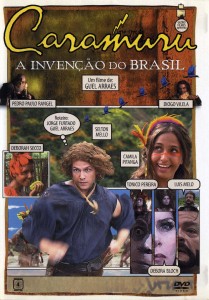Director: Guel Arraes
Writer: Guel Arraes, Jorge Furtado
Actors: Selton Mello, Camila Pitanga, Deborah Secco
Production Co.: Globo Filmes
Country: Brazil
Year: 2001
Language: Portuguese, with optional Portuguese, English, and Spanish subtitles.
Format: DVD
Summary: A spoof on Brazilian colonial history. After his caravel sinks, Portuguese map illustrator Diogo Álvares reaches the Brazilian coast. He is saved by the Indian chief Itaparica and his two daughters, Paraguaçu and Moema, who call him Caramuru. But the chance to return to Portugal arises, and Caramuru realizes that this happy love triangle cannot last.


The film, Caramuru, the Invention of Brazil, by Guel Arraes highlights the union of two worlds to create a new national identity in Brazil. Paraguaçu and Caramuru literally marry, showing that one cannot neglect to think about the Portuguese and indigenous influence when considering Brazilian identity. They are interconnected in a new national identity. The text shows a change of culture and a willingness of Caramuru and Paraguaçu to learn about each other.
This film is an interpretation of the invention of Brazil and how different cultures came together to make one Brazilian culture. The cultures highlighted are the Portuguese and the indigenous tribe, Tupi. The film doesn’t necessarily stick to the actual factual history of Brazil, but instead takes pieces of the history and turns into a comedy where the audience is able to laugh and enjoy the movie while learning a bit about Brazilian history as well.
First of all, this is a comedy and to enjoy it I think it is best that we remember that other than the general plot there is not much factual integrity to this movie (otherwise the indígenas speaking portuguese and the cultural assimilation etc get weird).
The contrast between the European culture and the indigenous culture, the differences in interpretation and the romantic comedy that involves not two but three women for Diogo paves way for a laughter filled hour. Every character in this movie seems to try and outwit the other and the movie concludes in the victory of not only wits but also love.
The film, as stated in the above summary that our library provides, is a spoof on Portuguese/Brazilian colonial history. The historical facts pertaining to the Portuguese colonization of Brazil are less important in this portrayal which focuses more on the concepts of language and cultural identity and the barriers that had to be crossed during this time of European colonial expansion. The film does not show the often violent nature with which the colonizers took over indigenous communities by force and refused to adapt to a non-western lifestyle. This film is, in contrast, light and easy to follow and instead shows a different side of the relationship between the Portuguese colonizers and the Brazilian indigenous, as Caramuru (Portuguese) and Paraguaçu (Brazilian) ultimately get married and settle down in Brazil educating one another on each other’s customs and lifestyles as they form a happy union. The viewer can’t help but wonder if this message of happy marriage with compromises and sharing of ideas expands to the relationship at-large, post-colonization, between Portugal and Brazil.
This film provides a light and comedic interpretation of the early colonial days of Brazil. Though there may be satire and parody in segments of the film, it effectively communicates an essential aspect of colonization: the vast differences between the world of the colonists and the world of the colonized. This is portrayed through a rather twisted timeline of infatuations of Diogo, the main character. Overall, Caramuru is a funny and light depiction of early Brazil and oral tradition.
Caramuru is one of my favorite Brazilian films for its combination of humor and factual history. The film demonstrates how it would have been if a Portuguese male visited Brazil and a Brazilian woman visited Portugal early in the 1500s. The two world demonstration helps the viewer understand how difficult it was for these two distant cultures to come together. Ultimately, the union of a Portuguese male and an indigenous Brazilian woman introduces the new identity of Brazil.